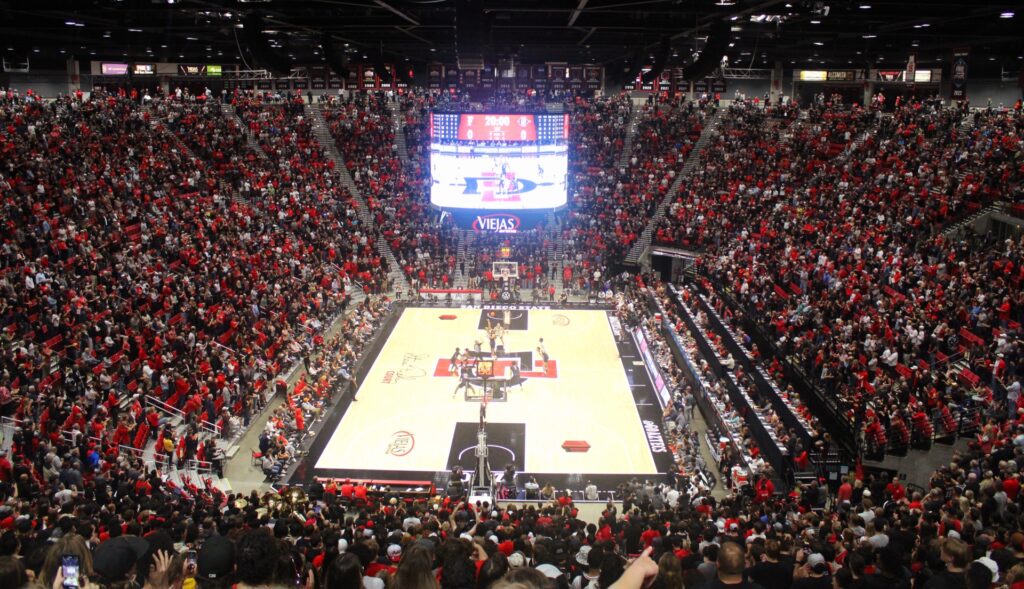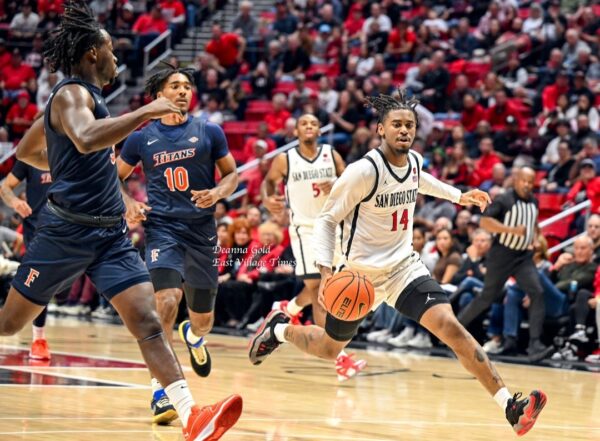SDSU seeks rare win against BYU in Provo

Viejas Arena at tip-off for the season opener against Fullerton. (Paul Garrison/EVT)

The Aztecs are coming off a victory on banner night, where they beat CSU Fullerton 83-57 behind dominating performances by Jaedon LeDee and Micah Parrish. Their next opponent is a BYU team that beat Houston Christian 110-63 on Monday night. The game is in Provo, where the Aztecs are 4-30 all-time against the Cougars.
SDSU’s wins in Utah have all been memorable. The first was on January 31, 1985. SDSU (7-2) and BYU (6-2) came into the contest with near identical conference records. Behind Leonard Allen’s season-high 29 points, the Aztecs prevailed 77-71. Leonard played exactly 1,000 minutes in the 1984-1985 season.
Showing how challenging winning in Provo is for SDSU, next victory came eleven years later on New Year’s Eve in Aztec Nation’s favorite BYU basketball season of all time. The Cougars finished 1-25 and 0-16 in conference in 1996-1997. Despite the struggles, the Aztecs needed overtime to win 89-86.
Chris Walton’s famous buzzer beater gave the Aztecs win number three. Marcus Slaughter’s game-high 17 points helped erase a nine-point halftime deficit. Walton’s heroics sealed the 59-57 win.
In 2019, Jordan Schakel connected on 5-7 from 3, lifting SDSU to a 76-71 victory. Malachi Flynn had 17 points and 5 assists. Given the history of futility on the road in the series, the victory gave the first significant hint that the 2019-2020 would be special.
SDSU seeks win number five on Friday.
General Observations
BYU, under Mark Pope has always been a good team, especially at home. The Cougars have never finished worse than 77th in KenPom during Pope’s tenure. This season, their first as members of the Big 12 Conference, is expected to be their best since 2021 due to the many complimentary pieces they have on both ends of the floor. Their balance will make them a great early test for the Aztecs. They are currently ranked 33rd by Kenpom, eight spots behind SDSU.
Defending BYU
BYU likes to run on offense. They will get up the floor in a flash. They know how to change ends of the court in one dribble or less. The Aztecs’ defense has to start in transition.
6’11 Noah Waterman finishing in transition pic.twitter.com/HZk5NqyO7i
— Aztec Breakdown (@aztecbreakdown) November 7, 2023
The easiest way to do that is to make shots. It’s harder to run after taking the ball out of the basket, so shot selection and making will be important to help the defense. Same thing goes for limiting turnovers.
If BYU doesn’t score early in the shot clock, Fousseyni Traore will often try to get position deep in the paint. The Aztecs’ centers will need to deny the 6-foot-6, 245-pound Traore deep position because he’s near automatic from around the rim. Traore had 14 points on 6 shots in last season’s matchup against SDSU, and that was with Nathan Mensah guarding him. Traore is an okay but not great passer from the post, so the Aztecs should try to send double teams at him to prevent him from getting going.
BYU also loves to chuck 3-point shots. 51.2% of their field goal attempts in their first game were from behind the arc. They have the shooters to be successful with it, too.
They will likely finish the season with five to eight players shooting 35% or better from deep. They are led by Spencer Johnson, who finished last year at 46.1%, good for 13th in the nation, according to KenPom.
That may work in the Aztecs’ favor. Last season, SDSU was 24-1 in games against opponents that took more than 38% of their shots from behind the arc. The Aztecs are generally elite at closing out on shooters, and they will likely continue to switch ball screens to prevent any easy pull-up jumpers.
Attacking BYU
BYU uses a wide array of defensive concepts. In screen coverages, they primarily deny, ice, or switch screens. The decisions are largely based on personnel, both offensive and defensive. For example, they might not switch a Butler-LeDee screen, but they would switch a LeDee-Heidi screen. Their aim with switches is to disrupt offensive flow while also not allowing mismatches.
BYU executing multiple switches pic.twitter.com/6OFMgXWkEY
— Aztec Breakdown (@aztecbreakdown) November 7, 2023
Against a switch, the Aztecs tend to run their offense until the defense makes a mistake or there is a mismatch to exploit. One matchup to look out for is LeDee vs Noah Waterman. Last season, LeDee drew multiple fouls on Waterman, all during the same possession, as Waterman couldn’t handle the physicality. Waterman is better now, but so is LeDee. Expect LeDee to attack if Waterman switches onto him.
SDSU doesn’t provide many opportunities to ice ball screens. Icing a ball screen involves denying the on-ball screen while also funneling the ball handler into a helping big, and almost exclusively takes place on a wing to funnel a ball handler into a corner.
BYU icing the screen pic.twitter.com/Bz3nzfdhtY
— Aztec Breakdown (@aztecbreakdown) November 7, 2023
If it happens, expect the Aztecs to kick the ball out to the screener who got denied. Guys like LeDee, Saunders, and Pal could all hit that shot if they decided, or they could also easily reverse the ball or flow into a handoff.
Off the ball, BYU utilizes screen denial. They prevent the effectiveness of screens by not allowing cutters to use the screens and gain separation. This forces offenses to succeed off-script when their plays aren’t working. They did that last season and had some success with it. The best possible counter is to back-cut the screen, as it will often result in a layup.
Screen denial back cut vs BYU pic.twitter.com/XwgpnND8A6
— Aztec Breakdown (@aztecbreakdown) November 7, 2023
Denying screens also makes it harder for defenders to help off the dribble. LeDee showed last season he can create for himself if BYU denies passes to his teammates. After his performance against Fullerton, he should be given the opportunity to do so.
LeDee can do a lot more of this this season. Aztecs trying to run off screens but BYU doing a great job of denying them. So LeDee ISO’s and gets the bucket. It’s one way to show his versatility despite playing the 5. pic.twitter.com/JsfOh9C9Hd
— Aztec Breakdown (@aztecbreakdown) July 14, 2023
In comparison to the screen coverages, BYU’s post coverage is really consistent. Whenever a ball handler is in the paint with their back to the basket, the double team comes immediately, and always from the player on the weakside closest to the baseline.
So, if there’s a big on the opposite block, that’s where the double team is coming from. If the opposite block is vacated, but there is a player in the weakside corner, that’s where the double team is coming from. On that backend, the next closest player plays a zone and guards two until the double team stops.
BYU baseline post double team. pic.twitter.com/zuIC1Mjgzx
— Aztec Breakdown (@aztecbreakdown) November 7, 2023
Beating it will require quick decisions, cuts, and passes. The player in the post can shoot before the second defender arrives. They can pass to a cutter or pass to one of the shooters that are only half-guarded.
BYU’s game plan in a nut shell. Switch screens, double the post, score in transition. pic.twitter.com/MaK9zlMA6w
— Aztec Breakdown (@aztecbreakdown) November 7, 2023
Play to watch for
Chicago series
Aztec fans should get really familiar with “Delay Chicago.” SDSU runs it all the time, and it’s a super popular action across the whole nation. BYU opened their exhibition with it, and it flowed into a Traore post-up that they then ran a split cut-off of. The execution was lacking, but the design is great.
Delay Chicago Punch Split pic.twitter.com/Yslagk4ZW1
— Aztec Breakdown (@aztecbreakdown) November 7, 2023
BYU has a lot of options out of Chicago actions, and one of their favorites is to take a jump shot if the defender goes under the screen and the handoff.
A popular option in BYU’s Chicago series. pic.twitter.com/LsFvjLkANU
— Aztec Breakdown (@aztecbreakdown) November 7, 2023
Players to watch for (stats from 2023)
Fousseyni Traore: 12.9 pts, 7.8 rebs, 1.5 asts.
Traore is the starting center for the Cougars. The junior averaged 13 points and eight rebounds last season. Despite his 6-foot-6 height, he is a beast down low. He’s helped by his long wingspan, and his technique in the post makes him very efficient. Traore shot 5-6 against the Aztecs last season, which was very impressive considering most of those shots came against DPOY Nathan Mensah. He also finished in the top 100 in both offensive and defensive rebounding rates. The Cougar big man had 6 points and nine rebounds in BYU’s opener.
Traore rim run pic.twitter.com/Bnwqkbtbo4
— Aztec Breakdown (@aztecbreakdown) November 7, 2023
Spencer Johnson: 11.1 pts, 3.6 rebs, 1.8 asts
Born on September 3, 1997, Spencer Johnson is the oldest player in college basketball this season at 26 years old. He was a problem for the Aztecs last season. He had a very efficient 17 points and added seven rebounds. He’s a classic 3&D player. As mentioned above, he shot 46.1% from deep last season, 13th best in the nation. He is also disruptive and led the WCC with a 4% steal percentage. (For context, Lamont Butler had a steal percentage of 3.5% last season.) Johnson will go off if the Aztecs let him, so they need to stay glued at all times. He showed off an expanded game against Houston Christian, where he finished with 20 points, five rebounds, and seven assists.
Spencer Johnson is a sniper pic.twitter.com/NnCs96kSqn
— Aztec Breakdown (@aztecbreakdown) November 7, 2023
Jaxson Robinson: 8.5 pts, 2.9 rebs, 1.8 asts.
Robinson is set for a breakout season. After transferring from Arkansas, he started 30 games for BYU last season. He looked like a transfer in the sense that he wasn’t always sure about what to do or where to be. That shouldn’t be a problem this year. He scored 20 points on 7-10 shooting in BYU’s exhibition and followed that up with 13 points against Houston Christian. A Top 100 recruit out of high school, he has all the physical tools to be an impact player. He’s 6-foot-7 inches tall with a 7-foot wingspan, which allows him to guard almost anyone and score over most of the players he’ll face.
X-Factor: Transition play
Through one game, both BYU and SDSU rank in the top 20 in offensive pace, according to KenPom. BYU wants to run, and it seems SDSU wants to run as well. That should favor BYU as they have more proven depth and are used to playing at elevation. Stopping BYU in transition is the single biggest deciding factor in this game.
Native San Diegan living in Montana. Big time Aztec Basketball fan. Creator of Aztec Breakdown. Hoping to help people enjoy basketball more by increasing their understanding of it.